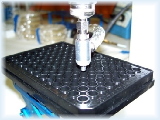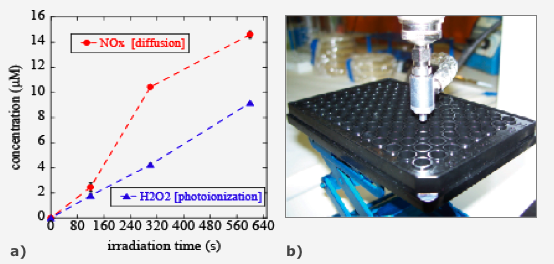| |
|
|
|
|
|
|
Plasma Biology
 Back to Plasma Biology
Back to Plasma Biology

2. Effects of plasma irradiation on human cells
Bactericidal properties of such plasma components as reactive oxygen and nitrogen
species, charged particles, and UV radiation make plasmas a promising tool for the
disinfection of chronic wounds as an addition or even an alternative to antibiotic
therapy, in particular where antibiotic resistant bacteria are encountered.
However, these plasma components are not bacteria-specific. They also affect
mammalian cells in a dosage-dependent manner. We are using an in vitro
approach to identify such a plasma composition and dosage that would cause
significant reduction of bacterial density in infected wounds without causing any
negative effect on human cells and tissues.

Figure 2. Effects of plasma-irradiated liquids on bacteria and human skin
fibroblasts. Cultures of Escherichia coli were treated with PBS (a)
and LB medium (b) irradiated with plasma for 2-10 min. Cultures of human skin
fibroblasts were treated with DMEM medium irradiated with plasma for 5 and 10
min (c). Control samples were prepared in non-irradiated or UV-irradiated liquids.
Bacterial density in treated and control samples was assayed after 60 minutes
incubation at room temperature (a and b). Cell viability and proliferation were
assayed during 120 hr. The results of this experiment show that plasma-irradiated
liquids inhibit bacterial growth. Incubation in plasma-irradiated medium does not
significantly affect fibroblast viability, but alters cell proliferation in a
dosage-dependant manner. Medium irradiated with plasma for 5 min induces cell
proliferation, as medium irradiated for 10 min causes temporary cell cycle arrest
in G2 phase and, therefore, inhibition of cell proliferation. This result suggests
that plasma treatment can be optimized to cause inhibition of bacterial growth in
the wound area and stimulating human cell proliferation (and therefore wound
closure) at the same time.
Plasma-generated UV radiation
Low-temperature atmospheric pressure plasmas produce polychromatic UV radiation,
composed of UVC (200-280 nm), UVB (280-320 nm), and UVA (320-400 nm). UV radiation
(in particular, UVC) is known as a mutagenic factor that can alter the DNA structure.
Therefore, the intensity and spectral characteristics of plasma-generated UV should
be taken into account when plasmas are designed for medical applications.
The International Commission on Non-Ionizing Radiation Protection (ICNIRP) provides
guidelines on the safety doses of UV radiation for healthy human skin. However, no
regulation exists for acceptable dosages of different wavelength UV radiation for
the treatment of damaged skin (wounds). We are using cultures of human skin
fibroblasts and keratinocytes to identify cytotoxic limits of plasma-generated UV
radiation. In addition, we are estimating bactericidal contribution of
plasma-generated UV relative to other biologically active plasma-components. Based
on these measurements, we are developing recommendations on the limits of
plasma-generated UV in application for wound treatment.
Plasma-generated reactive oxygen and nitrogen species

Figure 3. Concentration of reactive oxygen and nitrogen species (a) in liquids
irradiated using the argon plasma torch (b). Argon plasma generates reactive
oxygen and nitrogen species at physiologically-low concentrations in the
irradiated liquids. There are two main sources of reactive species in
plasma-irradiated liquids: diffusion from the gas phase (red curve) and liquid
photo ionization (blue curve).
Reactive oxygen and nitrogen species are known to play fundamental roles in
natural antibacterial and antiviral defense in mammalian organisms. Reactive
species are also major players of plasma sterilization. What is the optimal
composition of reactive species for wound sterilization? To answer this question
we are currently working on the following:
- Study of the effects of plasma irradiation on human cells
- Study of the effect of plasma-irradiated liquids on human cells
- Chemical analyses of plasma-irradiated liquids
- Comparison of cell (and bacterial) response to plasma irradiation with
effects achieved by cell (and bacteria) exposure to chemical compounds-carriers
of reactive species
Besides their bactericidal properties, reactive species are known as signal
molecules involved in regulation of cell proliferation, differentiation,
migration, and apoptosis. Low concentrations of exogenous plasma-generated
reactive species may be used for the regulation of the wound healing process.
Since chronic wounds have different underlying etiology and, therefore,
different 'chemistry', plasmas for wound healing should be optimized for
different types of wounds. Based on chemical characteristics of wound fluid
(e.g. concentration of nitrates and nitrites), we are developing a
classification of wound types for a smart plasma therapy.
Read more:
- Bactericidal and antiviral effects of
plasma irradiation
 Top of page
Top of page
|
|
|
|
| |
|
|